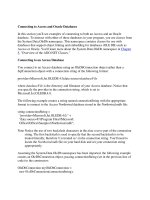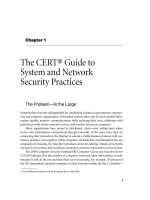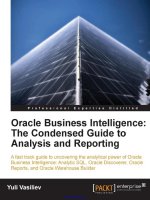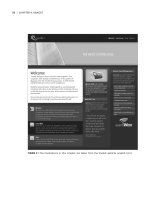Guide to cleaning and preparing data
Bạn đang xem bản rút gọn của tài liệu. Xem và tải ngay bản đầy đủ của tài liệu tại đây (1.03 MB, 26 trang )
Follow
562K Followers
·
Editors' Picks
Features
Explore
Contribute
About
You have 2 free member-only stories left this month. Sign up for Medium and get an extra one
A Straightforward Guide to
Cleaning and Preparing Data in
Python
How to Identify and deal with dirty data.
Frank Andrade 7 hours ago · 10 min read
Create PDF in your applications with the Pdfcrowd HTML to PDF API
PDFCROWD
Photo by jesse orrico on Unsplash
Real-world data is dirty. In fact, around 80% of a data scientist's time is
spent collecting, cleaning and preparing data. These tedious (but
necessary) steps make the data suitable for any model we want to build and
ensure the high quality of data.
Create PDF in your applications with the Pdfcrowd HTML to PDF API
PDFCROWD
The cleaning and preparation of data might be tricky sometimes, so in this
article, I would like to make these processes easier by showing some
techniques, methods and functions used to clean and prepare data. To do
so, we’ll use a Netflix dataset available on Kaggle that contains information
about all the titles on Netflix. I’m using movie datasets because they’re
frequently used in tutorials for many data science projects such as
sentiment analysis and building a recommendation system. You can also
follow this guide with a movie dataset from IMDb, MovieLens or any
dataset that you need to clean.
Although the Kaggle dataset might look well organized, it’s not ready to be
used, so we’ll identify missing data, outliers, inconsistent data and do text
normalization. This is shown in detail in the table below.
Table of Contents
1. Quick Dataset Overview
2. Identify Missing Data
- Create a percentage list with .isnull()
3. Dealing with Missing Data
- Remove a column or row with .drop, .dropna or .isnull
- Replace it by the mean, median or mode
- Replace it by an arbitrary number with .fillna()
4. Identifying Outliers
- Using histograms to identify outliers within numeric data
- Using boxplots to identify outliers within numeric data
Create PDF in your applications with the Pdfcrowd HTML to PDF API
PDFCROWD
5.
6.
7.
8.
-
Using bars to identify outliers within categorical data
Dealing with Outliers
Using operators & | to filter out outliers
Dealing with Inconsistent Data Before Merging 2 Dataframes
Dealing with inconsistent column names
Dealing with inconsistent data type
Dealing with inconsistent names e.g. "New York" vs "NY"
Text Normalization
Dealing with inconsistent capitalization
Remove blank spaces with .strip()
Remove or replace strings with .replace() or .sub()
Merging Datasets
Remove duplicates with .drop_duplicates()
1. Quick Dataset Overview
The first thing to do once you downloaded a dataset is to check the data
type of each column (the values of a column might contain digits, but they
might not be datetime or int type)
After reading the CSV file, type
.dtypes
to find the data type of each
column.
df_netflix_2019 = pd.read_csv(‘netflix_titles.csv’)
df_netflix_2019.dtypes
Create PDF in your applications with the Pdfcrowd HTML to PDF API
PDFCROWD
Once you run that code, you’ll get the following output.
show_id
type
title
director
cast
country
date_added
release_year
rating
duration
listed_in
description
dtype: object
int64
object
object
object
object
object
object
int64
object
object
object
object
This will help you identify whether the columns are numeric or categorical
variables, which is important to know before cleaning the data.
Now to find the number of rows and columns, the dataset contains, use the
.shape
method.
In [1]: df_netflix_2019.shape
Out[1]: (6234, 12) #This dataset contains 6234 rows and 12 columns.
Create PDF in your applications with the Pdfcrowd HTML to PDF API
PDFCROWD
2. Identify Missing Data
Missing data sometimes occurs when data collection was done improperly,
mistakes were made in data entry, or data values were not stored. This
happens often, and we should know how to identify it.
Create a percentage list with .isnull()
A simple approach to identifying missing data is to use the
.sum()
.isnull()
and
methods
df_netflix_2019.isnull().sum()
This shows us a number of “NaN” values in each column. If the data
contains many columns, you can use
.sort_values(ascending=False)
to
place the columns with the highest number of missing values on top.
show_id
type
title
director
cast
0
0
0
1969
570
Create PDF in your applications with the Pdfcrowd HTML to PDF API
PDFCROWD
country
date_added
release_year
rating
duration
listed_in
description
dtype: int64
476
11
0
10
0
0
0
That being said, I usually represent the missing values in percentages, so I
have a clearer picture of the missing data. The following code shows the
above output in
%
Now it’s more evident that a good number of directors were omitted in the
dataset.
show_id: 0.0%
type: 0.0%
title: 0.0%
director: 31.58%
cast: 9.14%
country: 7.64%
date_added: 0.18%
release_year: 0.0%
rating: 0.16%
duration: 0.0%
Create PDF in your applications with the Pdfcrowd HTML to PDF API
PDFCROWD
listed_in: 0.0%
description: 0.0%
Now that we identified the missing data, we have to manage it.
3. Dealing with Missing Data
There are different ways of dealing with missing data. The correct approach
to handling missing data will be highly influenced by the data and goals
your project has.
That being said, the following cover 3 simple ways of dealing with missing
data.
Remove a column or row with .drop, .dropna or .isnull
If you consider it’s necessary to remove a column because it has too many
empty rows, you can use
.drop()
and add
axis=1
as a parameter to
indicate that what you want to drop is a column.
Create PDF in your applications with the Pdfcrowd HTML to PDF API
PDFCROWD
However, most of the time is just enough to remove the rows containing
those empty values. There are different ways to do so.
The first solution uses
.drop
with
axis=0
to drop a row. The second
identifies the empty values and takes the non-empty values by using the
negation operator
~
while the third solution uses
.dropna
to drop empty
rows within a column.
If you want to save the output after dropping, use
inplace=True
as a
parameter. In this simple example, we’ll not drop any column or row.
Replace it by the mean, median or mode
Another common approach is to use the mean, median or mode to replace
the empty values. The mean and median are used to replace numeric data,
while the mode replaces categorical data.
As we’ve seen before, the
rating
column contains 0.16% of missing data.
We could easily complete that tiny portion of data with the mode since the
rating
is a categorical value.
Create PDF in your applications with the Pdfcrowd HTML to PDF API
PDFCROWD
First, we calculated the mode (TV-MA), and then we filled all the empty
values with
.fillna .
Replace it by an arbitrary number with .fillna()
If the data is numeric, we can also set an arbitrary number to prevent
removing any row without affecting our model's results.
If the
e.g.
duration
column was a numeric value (currently, the format is string
90 minutes ), we could replace the empty values by 0 with the following
code.
df_netflix_2019['duration'].fillna(0, inplace=True)
Also, you can use the
ffill
,
bfill
to propagate the last valid observation
forward and backward, respectively. This is extremely useful for some
datasets but it’s not useful in the
df_netflix_2019
dataset.
4. Identifying Outliers
Create PDF in your applications with the Pdfcrowd HTML to PDF API
PDFCROWD
An outlier is that data that that differs significantly from other
observations. A dataset might contain real outliers or outliers obtained after
poor data collection or caused by data entry errors.
Using histograms to identify outliers within numeric data
We’re going to use the duration as a reference that will help us identify
outliers in the Netflix catalog. The
duration
column is not considered a
numerical value (e.g., 90) in our dataset because it’s mixed with strings
(e.g., 90 min). Also, the duration of TV shows is in seasons (e.g., 2 seasons)
so we need to filter it out.
With the following code, we’ll take only movies from the dataset and then
extract the numeric values from the
duration
column.
Now the data is ready to be displayed in a histogram. You can make plots
with matplotlib, seaborn or pandas in Python. In this case, I’ll do it with
matplotlib.
import matplotlib.pyplot as plt
Create PDF in your applications with the Pdfcrowd HTML to PDF API
PDFCROWD
fig, ax = plt.subplots(nrows=1, ncols=1)
plt.hist(df_movie[‘minute’])
fig.tight_layout()
The plot below reveals how the duration of movies is distributed. By
observing the plot, we can say that movies in the first bar (3'–34') and the
last visible bar (>189') are probably outliers. They might be short films or
long documentaries that don’t fit well in our movie category (again, it still
depends on your project goals)
Create PDF in your applications with the Pdfcrowd HTML to PDF API
PDFCROWD
Image by author
Using boxplots to identify outliers within numeric data
Another option to identify outliers is boxplots. I prefer using boxplots
because it leaves outliers out of the box’s whiskers. As a result, it’s easier to
identify the minimum and maximum values without considering the
outliers.
We can easily make boxplots with the following code.
import seaborn as sns
fig, ax = plt.subplots(nrows=1, ncols=1)
ax = sns.boxplot(x=df_movie[‘minute’])
fig.tight_layout()
The boxplot shows that values below 43' and above 158' are probably
outliers.
Create PDF in your applications with the Pdfcrowd HTML to PDF API
PDFCROWD
Image by author
Also, we can identify some elements of the boxplot like the lower quartile
(Q1) and upper quartile (Q3) with the .describe() method.
In [1]: df_movie[‘minute’].describe()
Out [1]: count
4265.000000
mean
99.100821
Create PDF in your applications with the Pdfcrowd HTML to PDF API
PDFCROWD
std
min
25%
50%
75%
max
28.074857
3.000000
86.000000
98.000000
115.000000
312.000000
In addition to that, you can easily display all elements of the boxplot and
even make it interactive with Plotly.
import plotly.graph_objects as go
from plotly.offline import iplot, init_notebook_mode
fig = go.Figure()
fig.add_box(x=df_movie[‘minute’], text=df_movie[‘minute’])
iplot(fig)
Using bars to identify outliers within categorical data
In case the data is categorical, you can identify categories with few
observations by plotting bars.
In this case, we’ll use the built-in Pandas visualization to make the bar plot.
Create PDF in your applications with the Pdfcrowd HTML to PDF API
PDFCROWD
fig=df_netflix_2019['rating'].value_counts().plot.bar().get_figure()
fig.tight_layout()
Image by author
In the plot above, we can see that the mode (the value that appears most
often in the column) is ‘TV-MA’ while ‘NC-17’ and ‘UR’ are uncommon.
Create PDF in your applications with the Pdfcrowd HTML to PDF API
PDFCROWD
5. Dealing with Outliers
Once we identified the outliers, we can easily filter them out by using
Python’s operators.
Using operators & | to filter out outliers
Python operators are simple to memorize.
while | is the equivalent of
&
is the equivalent of
and ,
or .
In this case, we’re going to filter out outliers based on the values revealed by
the boxplot.
#outliers
df_movie[(df_movie['minute']<43) | (df_movie['minute']>158)]
#filtering outliers out
df_movie = df_movie[(df_movie['minute']>43) & (df_movie['minute']
<158)]
The
df_movie
created now contains only movies that last between 43' and
158'.
Create PDF in your applications with the Pdfcrowd HTML to PDF API
PDFCROWD
6. Dealing with Inconsistent Data Before Merging 2
Dataframes
A common task we often come across is merging dataframes to increase the
information of an observation. Unfortunately, most of the time, datasets
have many inconsistencies because they come from different sources.
From now on, we’ll use a second dataset
df_netflix_originals
that
contains only Netflix originals (.csv available on my Github), and we’ll
merge it with the original dataset
df_netflix_2019
to determine
original and non-original content.
Dealing with inconsistent column names
A common issue we have to deal with is different column names between
tables. Column names can be easily changed with the
.rename
method.
Dealing with inconsistent data type
If you try to merge 2 datasets based on a column that has different data
types, Python will throw an error. That’s why you have to make sure the
Create PDF in your applications with the Pdfcrowd HTML to PDF API
PDFCROWD
type is the same. If the same column have different types, you can use the
.astype
method to normalize it.
Dealing with inconsistent names e.g., “New York” vs. “NY”
Usually, the column and data type normalization is enough to merge to
datasets; however, sometimes, there are inconsistencies between the data
within the same column caused by data entry errors (typos) or
disagreements in the way a word is written.
Movies titles don’t usually have these problems. They might have a
disagreement in punctuation (we’ll take care of this later), but movies
usually have a standard name, so to explain how to deal with this problem,
I’ll create a dataset and a list containing states written in different ways.
There are many libraries that can help us solve this issue. In this case, I’ll
use the
fuzzywuzzy
library. This will give a score based on the distance
between 2 strings. You can choose the scorer that fits your data better. I will
set
scorer=fuzz.token_sort_ratio
Create PDF in your applications with the Pdfcrowd HTML to PDF API
in this example.
PDFCROWD
As we can see in the output, the scorer does a good job matching strings.
states
CA
Hawai
NY
Washington DC
match
California
Hawaii
New York
Washington
score
33
91
40
87
However, keep in mind that it can still match wrong names.
7. Text Normalization
Text normalization is necessary for Natural Language Processing. This
involves the following techniques to make text uniform.
Removing whitespace, punctuation and non-alphanumeric characters
Tokenization, Stemming, Lemmatization, removing stop words
To make things simple, this article will only cover the first point. However,
you can an overview of how to deal with tokenization and stop words in this
article I wrote (check the Methodology section)
Create PDF in your applications with the Pdfcrowd HTML to PDF API
PDFCROWD
Dealing with inconsistent capitalization
Before merging 2 frames, we have to make sure most rows will match, and
normalizing capitalization helps with it.
There are many ways to lower case text within a frame. Below you can see
two options ( .apply or
.str.lower )
Remove blank spaces with .strip()
Sometimes data has leading or trailing white spaces. We can get rid of them
with the
.strip
method
Remove or replace strings with .replace() or .sub()
Texts between two datasets often have disagreements in punctuation. You
can remove it with
.apply and .sub
or by using
.replace
It’s good to use any of them with regular expressions. For example, the
regex [^\w\s] will help you remove characters other than words (a-z, A-Z,
0–9, _ ) or spaces.
Create PDF in your applications with the Pdfcrowd HTML to PDF API
PDFCROWD
8. Merging Datasets
Finally, we can merge the dataset
df_netflix_originals
and
df_netflix_2019 . With this, we can identify which movies are Netflix
originals and which only belong to the catalog. In this case, we do an outer
join to give ‘Catalog’ value to all the rows with empty values in the
" Original" column.
Remove duplicates with .drop_duplicates()
One of the pitfalls of outer join with 2 key columns is that we’ll obtain
duplicated rows if we consider a column alone. In this case, we merged
based on the
titles
title
and
release_year
duplicated that have different
columns, so most likely there are
release_year .
You can drop duplicates within a column with the
.drop_duplicates
method
The data grouped by type and origin is distributed like this.
Create PDF in your applications with the Pdfcrowd HTML to PDF API
PDFCROWD
In[1]: df_netflix[['original', 'type']].value_counts()
Out[1]:
original
Catalog
Netflix
type
Movie
TV Show
TV Show
Movie
3763
1466
1009
504
That’s it! Now the data is clean and ready to be processed! You can still
clean more (if necessary) or use your data in your data science project as I
did to find the best Netflix and Disney movies to learn a foreign language
(NLP projects)
The Best Movies to Learn a Foreign Language According to Data
Science
The largest analysis ever of vocabulary in movie dialogue. Find out
which of the top 3000 movies analyzed are the best…
towardsdatascience.com
Create PDF in your applications with the Pdfcrowd HTML to PDF API
PDFCROWD
Some projects where I wrangled real-world data are the following:
I Used to Pay $180/yr for a Profitable Betting Tool. This Year I Built
One in Python
Full code to create a football betting tool with Pandas and Selenium.
medium.datadriveninvestor.com
Make Money With Python — The Sports Arbitrage Project
Full code to make extra money with sports arbitrage.
medium.datadriveninvestor.com
The code behind this analysis is available on my Github.
Sign up for The Variable
By Towards Data Science
Every Thursday, the Variable delivers the very best of Towards Data Science: from
hands-on tutorials and cutting-edge research to original features you don't want to
Create PDF in your applications with the Pdfcrowd HTML to PDF API
PDFCROWD
miss. Take a look.
Get this newsletter
Your email
By signing up, you will create a Medium account if you don’t already have one. Review our Privacy Policy for more information
about our privacy practices.
104
Data Science
Python
Technology
Education
Artificial Intelligence
More from Towards Data Science
Follow
Your home for data science. A Medium publication sharing concepts, ideas and
codes.
Read more from Towards Data Science
Create PDF in your applications with the Pdfcrowd HTML to PDF API
PDFCROWD









